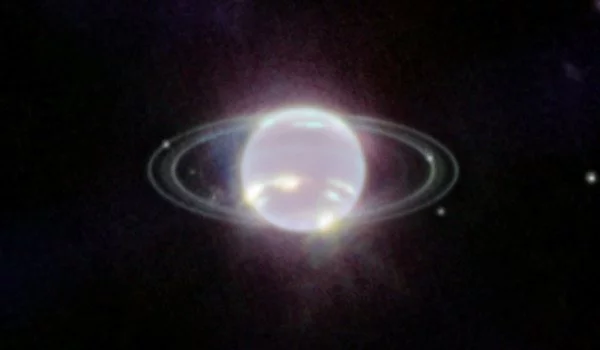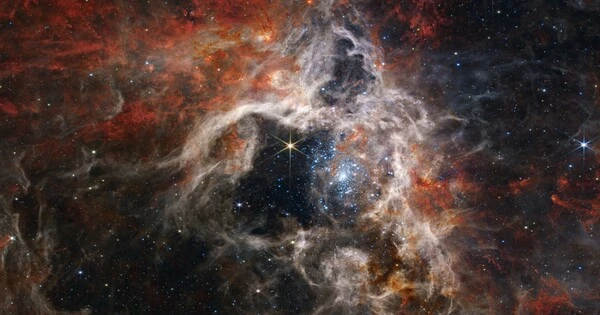The James Webb Space Telescope (JWST) is a powerful space observatory launched by NASA that is designed to study distant objects in the universe such as planets, stars, and galaxies. Given its advanced capabilities, it is possible that JWST will capture breathtaking images of Saturn and its rings, providing new insights and detailed observations of this magnificent gas giant. Saturn’s iconic rings appear to glow eerily in this incredible infrared image, which also reveals unexpected features in Saturn’s atmosphere. Please see the image link below.
This image provides context for an observing program that will put the telescope’s ability to detect faint moons around the planet and its bright rings to the test. Any newly discovered moons could help scientists put together a more complete picture of the current system of Saturn, as well as its past.
At the specific infrared wavelength (3.23 microns) depicted in this image, methane gas absorbs nearly all of the sunlight falling on the atmosphere. As a result, Saturn’s well-known striped patterns are obscured by the methane-rich upper atmosphere, which obscures our view of the primary clouds. Instead, the disc of Saturn appears dark, and we see features associated with high-altitude stratospheric aerosols, such as large, dark, and diffuse structures in Saturn’s northern hemisphere that do not align with the planet’s latitude lines. Interestingly, similar wave-like features were discovered in early JWST NIRCam observations of Jupiter.
We are very pleased to see JWST produce this beautiful image, which is confirmation that our deeper scientific data also turned out well. We’re excited to dig into the deep exposures and see what surprises await.
Dr. Matthew Tiscareno
Saturn’s rings, unlike its atmosphere, lack methane, so at this infrared wavelength, they are no darker than usual and easily outshine the darkened planet. This new image of Saturn also shows intricate details within the ring system, as well as a number of the planet’s moons such as Dione, Enceladus, and Tethys.
“We are very pleased to see JWST produce this beautiful image, which is confirmation that our deeper scientific data also turned out well,” said Dr. Matthew Tiscareno, the SETI Institute’s senior research scientist who led the process of designing this observation. “We’re excited to dig into the deep exposures and see what surprises await.”
Over the past few decades, missions like NASA’s Pioneer 11, Voyagers 1 and 2, the Cassini spacecraft and the Hubble Space Telescope have observed Saturn’s atmosphere and rings. The image captured by JWST is just a taste of what this observatory will uncover about Saturn in the coming years as scientists. This image is part of a suite of deeply exposed images where researchers hope to identify new ring structures and perhaps even new moons of Saturn.

Moving from the inner to the outer features of Saturn’s rings, we can observe the dark C ring, the bright B ring, the narrow and dark Cassini Division, and the medium-bright A ring with the dark Encke Gap near its outer edge. Additionally, off the outer edge of the A ring, we can see the narrow strand known as the F ring. The rings cast a shadow on the planet and vice versa, creating intriguing visual effects.
In-depth exposures not shown in this image will allow scientists to study Saturn’s fainter rings, such as the thin G ring and diffuse E ring, which are not visible in this image. Saturn’s rings are made up of a variety of rocky and icy fragments ranging in size from a grain of sand to mountains on Earth. JWST was recently used to explore Enceladus, and researchers discovered a large plume emanating from the moon’s southern pole. This plume contains particles as well as a large amount of water vapour, which contributes to Saturn’s E ring.
In this image, we can see typical seasonal changes between Saturn’s northern and southern poles. Saturn’s northern hemisphere is currently in summer, while the southern hemisphere is emerging from winter darkness. The northern pole, on the other hand, appears unusually dark, possibly due to an unknown seasonal process affecting polar aerosols. A faint brightening at the edge of Saturn’s disc could be attributed to high-altitude methane fluorescence or emission from the trihydrogen ion (H3+) in the ionosphere. JWST spectroscopy could help confirm these possibilities.





